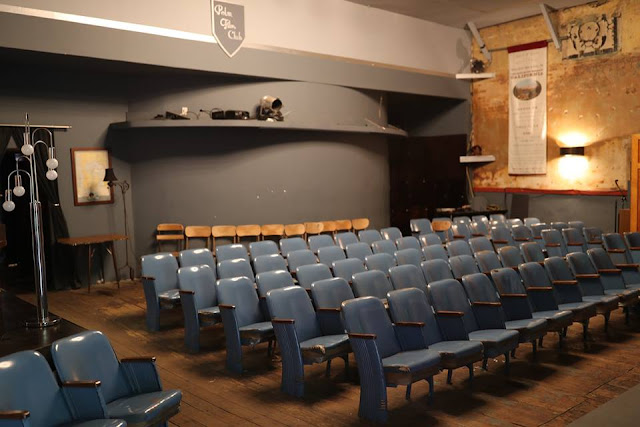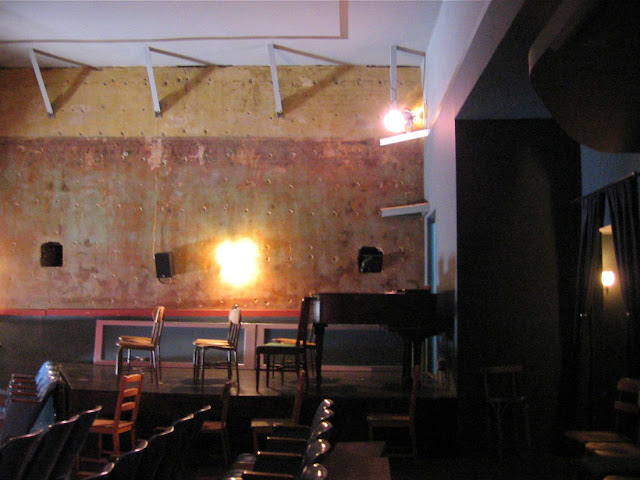Phone: 213-746-2166 Website: www.panoramaonview.org
The Shengjing Panorama was unveiled in June 2019. It's a 360° collaboration between the Velaslavasay Panorama and experts of Chinese panorama painting Li Wu, Yan Yang, and Zhou Fuxian. It depicts an urban Chinese landscape during the years 1910 to 1930, an era of great technological change, global exchange, and diversity in architecture, religions, and culture.
Architect: Frank L. Stiff designed the building for the Union Square Investment Co. The firm was noted in the January 30, 1906 issue of the Los Angeles Herald as a new incorporation with H.D. Requa, C.J. Requa and R.W. Kinsey as directors. The item appears on the website of the California Digital Newspaper Collection.
The building permit was issued on September 1, 1910. It lists the size of the building as 44' x 87' with an estimated cost of $4,250.00. Thanks to Noirish Los Angeles contributor Tovangar2 for researching this for Noirish post #41879.
Seating: 400 originally. In 1935 it was listed as having 385. Currently only about 10 rows remain at the front of the original theatre space.
The location of the theatre was once a bustling one. Wendell Benedetti comments:
The triangular park just east of the theatre, now referred to by some as "Hoover Triangle," had been designated by the merchants in the area as "Union Square" in 1905. Thanks to Noirish Los Angeles contributor Ethereal Reality for finding this January 29, 1905 Los Angeles Herald article for Noirish post # 41884.
A L.A. Times item located by Rina Rubenstein, also from January 29, 1905, commented:
"The business suburb at the junction of Union avenue and Hoover and Twenty-fourth streets has been christened 'Union Square' by the businessmen of that vicinity. A committee appointed by the Union Square Improvement Association is arranging for an electric illuminated sign which will be placed at that point."
Rina also located this March 6, 1906 Times item:
"UNION SQUARE - An enthusiastic meeting of citizens of Union Square was held on Tuesday evening at Henderson's Hall. Speeches were made by ex-Councilman W.M. Bowen and C.P. Squires, and working plans for the future were formulated. Street lights have been placed along the sidewalks on Union avenue, Twenty-third street and Hoover street. In all twenty-four lights have been installed."
The theatre evidently opened sometime in late 1910 or early 1911. It's unknown if this was the same location but in the 1910 city directory under "Moving Pictures and Machines" Rina Rubenstein found a listing for Bert W. Heard at "24th nr S Hoover." In the 1911 and 1913 directories it's listed as the Union Square Theatre at 1122 W. 24th. Rina notes that there wasn't a listing in 1912.
The Fairyland was listed with an address of 24th & Hoover in this 1922 column of ads located by Ken McIntyre.
"Call Theater For Program" is usually not a good phrase to see in an ad. Ken McIntyre located this one from October 1934.
A March 28, 1935 article about the April 4 opening of the Little Theatre with "Angel Cake." Thanks to Ken McIntyre for locating this for a Facebook thread about Ms. Glaum's various venues on Ken's Movie Page.
A March 1938 German/Korean double bill. Thanks to Ken for spotting the story. The theatre was listed as the Continental Cinema in the 1937 city directory and just as the Continental in 1938 and 1939.
Closing: The closing date is unknown. After ending its days as a film house, the building was in use as headquarters for a tile layers union. They had the building as early as 1956 -- they're in the phone book that year. After they left in the 1970s the building was used as a church.
Status: It reopened in June 2005 as a panorama, the Velaslavasay Panorama. The founder is Los Angeles artist Sara Velas.
The renovated complex retains theatre seating in the front of the auditorium for lectures, concerts and other events. Tucked into what was the rear of the main floor house left is an art gallery for changing displays. There's a lush garden out back as one goes through the exit doors on either side of the screen.
An upstairs area is devoted to the panorama itself, accessed by a spiral staircase in what would have been the middle of the auditorium. The staircase allows you to enter the 360 degree panorama in the center.
Atlas Obscura, a "Compendium of the World's Wonders, Curiosities and Esoterica" commented in a 2010 article on the building:
"In the late 1700s and early 1800s a new form of interactive media was invented. Considered lowbrow at the time, it was the 3D movie of its day, a fully engaging visual experience for the masses, known as panoramic paintings. Generally displayed either in a large circular room, and surrounding the viewer, or occasionally stretched across two rollers like a ribbon and cranked across them to create a moving landscape for the audience, they were wildly popular in their day. Good panorama painters, such as John Banvard (who at one point painted a half a mile long panorama, the longest in the world at the time), were made rich and famous. But with the advent of photography, optical toys and later film, panorama paintings all but disappeared, with most of the world forgetting they and their creators ever even existed."
Interior views:
Upstairs in the panorama viewing area. This one, called "Effulgence of the North" was accompanied by a 35 minute cycle of changing light patterns and a soundtrack appropriate for the arctic. Photo: Bill Counter - 2012
Another look at the "Effulgence" panorama by Sara Velas. The photo by James Ricci is one of many included with a 2010 article about the building on the site Atlas Obscura.
Looking back down the house right corridor toward the lobby. Photo: John Eder - Curbed L.A. - 2014
More street views:
More Information: See the Cinema Treasures page on the Velaslavasay Panorama for nice research by Joe Vogel. The site also has a separate page on the Fairyland Theatre. The assumption by Joe on the latter page is that the Fairyland was an earlier building and the present Union Theatre dates from 1921. However, the City's building permits show remodel work in 1920 but not a new building.
The Cinema Tour page on the Union has several 2003 exterior photos. Check out the 2010 Atlas Obscura article on the theatre and its panorama. Wendell Benedetti has a set of seven photos on the LAHTH Facebook page taken during that organization's 2017 annual meeting at the theatre. A 2014 Curbed L.A. article about the theatre includes many fine photos by John Eder.
Don't miss Sandi Hemmerlein's 2013 Avoiding Regret photo essay on the Union Theatre. There's also an October 2020 article about a return trip titled "The Only 19th-Century-Style Panorama West of the Mississippi.."
The blog History, Los Angeles County had a nice story about the Union in 2011. KPPC had a 2016 story about the neighborhood headed "Community involvement moves 'Hoover Triangle' revamp toward reality."
Founder Sara Velas inside the panorama. It's a photo by Madeline Hordinski that appeared with the 2021 Times article.
Nearby: Nearby at 1117 W. 24th is a small legit venue called the 24th St. Theatre that was built as a public garage in 1920. Thanks to Noirish Los Angeles contributor Tovangar2 for the research.
The La Tosca Theatre at 2930 S. Vermont also ran foreign films, including some from Germany.
More Information about other Panorama buildings: The "Panoramas in the Present Day" page of the Velaslavasay Panorama website has links to other extant buildings of this type. Also see the "Concise History of the Panorama" page for more history. The latter page includes this illustration of a traditional panorama building:














































Hi - Great article and thank you so much for always giving full credit to sources. You might have missed that in the 1927 & 1928 Los Angeles City Directories, it's listed as the Arbor theatre (at 1122 & 1126 W 24th, respectively).
ReplyDeleteThanks for all your meticulous research, Rina!
Delete